
Road near Bahia Concepcion, Baja California.
Part 6: Northern Baja California
Spanish version
Baja (Mexican) California, often called simply Baja, is much
less known than its Northern counterpart. Few visitors come here, and most of
them stay on the beaches of Cabo San Lucaz and Ensenada. Roads to most local attractions
are unpaved and bumpy, and distances are considerable. Still, it is possible to
see a lot of interesting things here, even on a one-week driving trip (although
a combination of a two-week driving trip and a two-week boat cruise of Sea of
Cortez would be much better). All photos on this page were obtained in six very
busy days in early March. They basically follow the length of the Peninsula from
North to South.
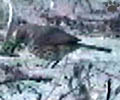
Gray thrasher (Toxostoma
cinerea), San Telmo. |
Northernmost part of Baja is very similar to San
Diego area of the US. If you travel along the Pacific coast, you have to drive
as far south as San Telmo, 160 km/100 miles from the border, to see Baja endemics
such as gray thrasher (left) or Baja kangaroo rat (Dipodomys gravipes). |
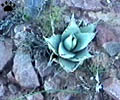
Baby coastal agave
(Agave showi), San Telmo. |
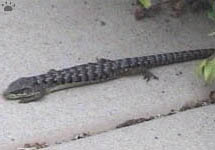
Southern alligator lizard (Gerrhonotus
multicarinatus), Point Cabrillo. |

Mission San Diego, one of
many along El Camino Real. |
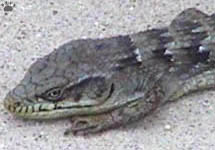
Southern alligator lizard (Gerrhonotus
multicarinatus), Point Cabrillo. |
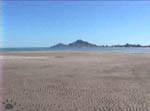
Northern tip of the Sea of Cortez has
tides up to 7.5 m (25') high, and
tidal mudflats up to 1 mile wide.
North from San Felipe. |
On the Eastern side, things get exciting much
sooner. First you cross Colorado River delta, once the most important wetland
of the Western North America, now mostly destroyed by US damming obsession. Then
you get to the northern tip of the Sea of Cortez, still a major bird wintering
area, home of the endemic vaquita porpoise. |
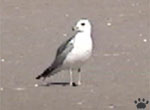
California gull (Larus californicus),
one of many shorebird species using
Baja coasts as wintering or stopover
sites. North from San Felipe. |
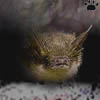
Fishing myotis (Myotis
vivens) can be found in
rock crevasses on Baja
shores, but it requires a
lot of effort. Near Loreto. |
Islands of the Sea of Cortez are sometimes called
"Mexican Galapagos". They have some excellent diving sites, and lots of plants
and animals occurring only there, such as black jackrabbit (Lepus insularis),
or rattleless rattlesnake (Crotalus catalinae). In addition, many species
almost extirpated on the mainland still survive there, such as the unique fishing
myotis (left), which now mostly breeds on Isla Partida in storm-petrel colonies,
but can occasionally be found on Baja coast. |

Marbled godwit
(Limosa fedoa) is one of
the most abundant
wintering shorebirds on
Baja coasts. San Felipe. |

Yellow-footed gull(L. livens)and brown
pelicans (Pelecanus occidentalis), Loreto. |
These islands are expensive to get to, and I'm
yet to visit most of them. Fortunately, seabirds that nest only on Baja islands
can often be seen on mainland coasts, and even in Alta California, where one of
them - Heermann's gull (right) has recently started breeding. |
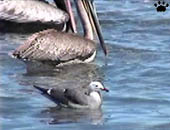
Heermann's gull (L. heermanni) and
brown pelicans, Loreto. |

Assorted small seashells from Sea of Cortez beaches. |
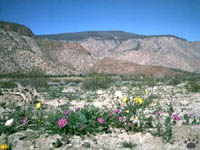
Flowers, San Felipe Desert near Puertecitos. |
San Felipe Desert in northeast Baja, along the
Sea of Cortez coast, is the driest and hottest part of North America, but in some
springs it has spectacular flower displays, similar to those of Mojave
and Sonora. |
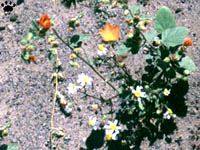
Flowers, San Felipe Desert near Puertecitos. |
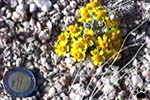
Woolly daisy (Eriophyllum
wallacei) near San Quintin. |
An even better place to see blooming desert in
spring is the western coast of Baja south from San Quintin. Many places in the
more southern parts of the Peninsula have some beautiful flowers at almost any
time of the year. |
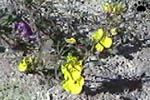
Baja wallflower (Erysimum
arenarius), San Quintin. |
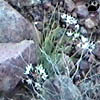 |
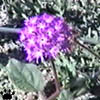 |
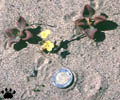 |
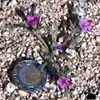 |
 |
| Desert flowers of Baja
California, left to right: Baja hyacinth (Ornythogalum albus), cave primrose
(Primula specuicola), Vizcaino primrose (Oenothera vizcainensis)
with common iceplant (Mesembryanthemum crystallinum), blue phacelia (Phacelia
distans), desert chicory (Rafinesquia neomexicana). |
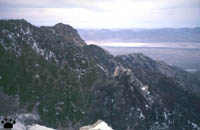
View of the Sea of Cortez from Sierra San Pedro
Martyr near the observatory. |
The most interesting (and coldest) part of Northern
Baja is Sierra San Pedro Martyr National Park, accessible via a very bumpy gravel
road from San Telmo. |
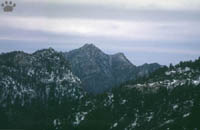
Picacho del Diablo (3096m/10300'),
Baja California's highest peak. |
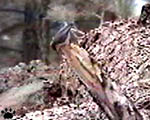
.
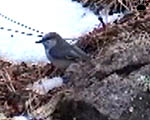
Pygmy nuthatch (Sitta pygmaea),
Sierra San Pedro Martyr. |
The park is famous for its vistas (all the way
to Deserto del Pinacate National Park in Sonora, Mexico), endemic flora (such
as cypress Cypressus arizonica var. montana) and fauna (including
trout Oncorhynchus mykiss nelsoni and squirrel Tamiasciurus mearnsii),
and for splendid old-growth forests of pines and firs. Unlike similar forests
of Sierra Nevada, these forests have never been
subjected to fire suppression, so they have more natural, park-like look. Probably
because the forest is very open, some arboreal birds, like this pygmy nuthatch
(left), often feed on the ground here. |

.

Coyote (Canis latrans),
Sierra San Pedro Martyr. |
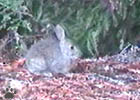 |
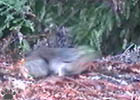 |
 |
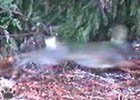 |
| Brush rabbit (Sylvilagus
bachmani), Sierra San Pedro Martyr. |

Desert cottontail (S. auduboni),
San Quintin. |
Highlands of Sierra San Pedro Martyr are the southernmost
place where many "northern" species occur. For example, brush rabbit
(above) is replaced by its relative, desert cottontail rabbit (left) further south
and at lower elevations. |
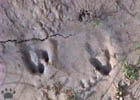
Tracks of desert cottontail,
Puerto Cancun. |
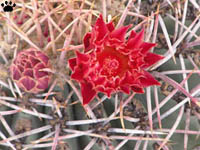
Fire barrel cactus (Ferocactus gracilis),
Bahia de los Angeles. |
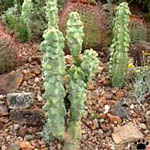
Totem pole cactus (Pachycereus scotti f. monstrosus),
Cerro Acho. |
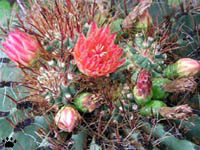
Emory'sbarrel cactus (F. emoryi),
Isla San Esteban. |

San Matias Pass, Sierra S.P.M.
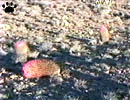
Barrel cacti F. fordii,
Laguna Chapala. |
Steep and dry, eastern slopes of Sierra San Pedro
Martyr are one of the best places in Baja to see barrel cactus (Ferocactus
spp). Even more spectacular groves of barrel cactus (with 9 endemic species),
mixed with numerous other cacti, grow on the hills around Laguna Chapala in the
central part of the Peninsula, currently protected as Desierto Central de Baja
California Natural Area. This Nature reserve, which stretches from Catavina Boulder
Field to Sierra La Primavera, has one of the World's most impressive examples
of desert vegetation. |
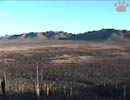
Dry lakebed of Laguna Chapala.
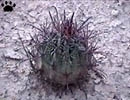
Baby barrel cactus F. gracilis,
L. Chapala. |
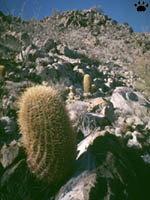
Barrel cacti F. cylindraceus growing
on rocks, San Matias Pass. |
 |
 |
| Flowers of barrel cactus F. peninsulae,
Laguna Chapala. |
 |
 |
| Barrel cactus F. chrysacanthus,
Laguna Chapala. |
|
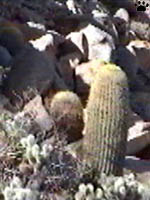
F. cylindraceus and chollas
(Opuntia sp.), San Matias Pass. |
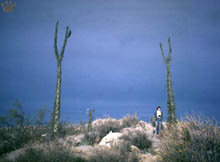
Boojums, Catavina.
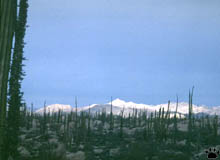
Boojum forest, Catavina. |
The most famous plant of Central Baja is almost-endemic
boojum tree (Foukuieria columnaris), known to locals as cirio ("large
candle"). It was named "boojum" after a character from L. Carroll's
The Hunting of the Snark. It's smaller relative, ocotillo, is much more widespread. |
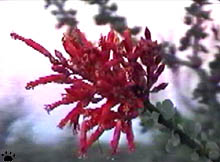
Ocotillo (F. splendens), Laguna Chapala.
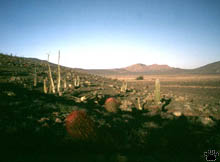
Boojums and cacti, Laguna Chapala. |
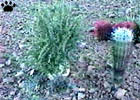 |
 |
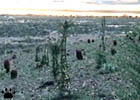 |
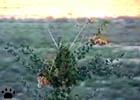 |
Young boojums look like
giant carrots planted upside down. They start blooming at the height of 1-2 m/3-6',
and grow up to 30 m/100'.
Laguna Chapala. |
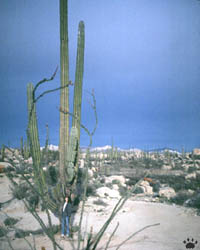
Cardon and ocotillo, Catavina. |
Another botanical wonder of Baja is cardon (Pachycereus
pringlei), world's tallest cactus. It grows throughout most of the peninsula,
from El Rosario south, even in the mountains, but the best cardonals (cardon
forests) are in Sierra de La Giganta and around Bahia Concepcion. |

Cardon, Laguna Chapala. |
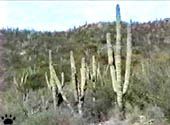
.
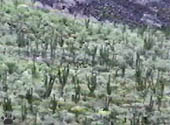
Cardonal stretching for hundred miles,
Sierra de la Giganta. |
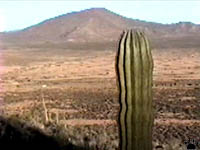
Cardon, with our car (white dot) in the background. Laguna Chapala.
Other large cacti of Baja include old man (right), candelabra, galloping, and
organ pipe cactus (below). Most of them bloom at night, and are pollinated by
bats. |
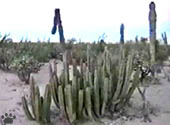
.
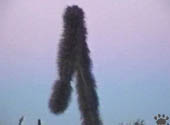
Old man cactus(Lophocereus schottii),
Catavina. |
 |
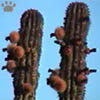 |
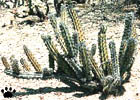 |
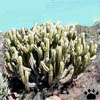 |
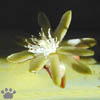 |
Organ pipe cactus (Lemaireocereus
thurberi), Catavina. |
Galloping cactus (Machaerocereus
gummosus), Puerto Cancun. |
Candelabra cactus (Myocactus
cochal),
Puerto Cancun. |
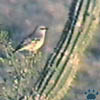
Northern mockingbird
(Mimus polyglottos),
Rio Candelaria. |

Crested caracaras
(Polyborus plancus),
Rio Candelaria. |
Vicinity of large cacti is often the best place
to look for birds. Songbirds, doves, raptors, owls, woodpeckers perch on cardon
and organ pipe cacti and nest in/on them. |
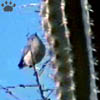
Blue-graygnutcatcher
(Polioptila caerulea),
Rio Candelaria. |
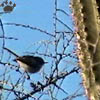
California gnutcatcher
(P. californica),
Rio Candelaria. |
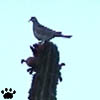
White-winged dove (Zenaida asiatica), Puerto Cancun. |

Cactus wren
(Campylorhynchus
brunneicapillus), Loreto. |
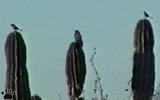
Loggerhead shrike (Lanius
ludovicianus), gilded flicker and
gray thrasher, Rio Candelaria. |
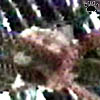
Costa's hummingbird
(Calypte costae)at nest,
Guerrero Negro. |

Gilded flicker
(Colaptes chrysoides),
Puerto Cancun. |
 |
 |
Altogether, Baja has 75 cactus species (including
about 50 endemics), and most of them are small. |
 |
 |
Silver cholla (Opuntia
echinocarpa), Catavina. |
Teddybear cholla (O.
bigelovii), Catavina. |
Wolf's cholla (O. wolfi),
Catavina. |
Mamillaria dioica
cactus, San Matias Pass. |
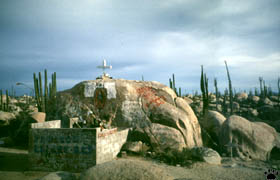
Roadside chapel among cardons and boojums, Catavina Boulder Field. |

Volcan Las Tres Virgenes (1920m/6,400') had last erupted in 1857. |

Elephant tree (Pachycomus discolor) grows on
boulders, rocks, and lava flows. Punta Final.

Elephant trees and boojums, Catavina. |
The most popular place to see the botanical wonders
of Baja is Catavina Boulder Field, with its oldgrowth boojum forests. As the rest
of of Baja's Central Desert, it is virtually unpopulated, and is an excellent
place for trekking, camping, and plant viewing, but finding mammals and other
animals here can be difficult. Well, at least it can be accessed via paved road
- the Transpeninsular Highway. |
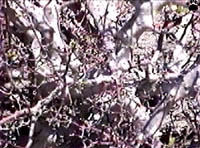
False elephant tree, or torote (Bursera
microphylla) grows on alluvial soils. Puertecitos.

Camping in the desert, Laguna Chapala. |
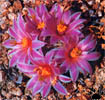
Pincushion cactus
(M. roja), Catavina. |
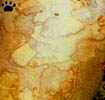
Elephant tree
bark, Catavina. |

Parry's agava (A.
parryi), San Quintin. |
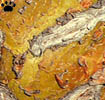
Ocotillo bark,
Volcan las Tres Virgenes. |

Flowers of Cochemia sp.
cactus, L. Chapala. |

Baja brush lizard
(Urosaurus lahtelai),
Catavina. |
Endemic animals of Central Baja often have very
small ranges. Baja brush lizard (left) is only known from Catavina Boulder Field,
rare Vizcaino thrasher (right) - from barren coastal desert around Vizcaino Peninsula.
There are dozens of unique spiders and scorpions, many of them known from only
one specimen each. |

Vizcaino thrasher
(Toxostoma arenicola),
Laguna San Ignacio. |
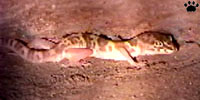
Banded gecko (Coleonyx variegatus), San Felipe Desert. |
Part 7: Southern Baja
Back to Part 5
Home
|